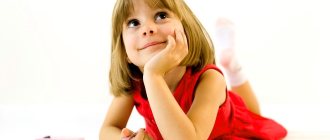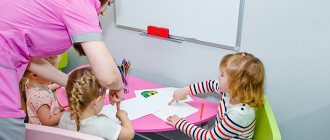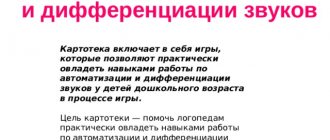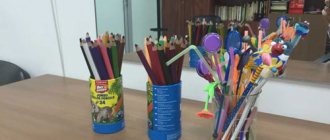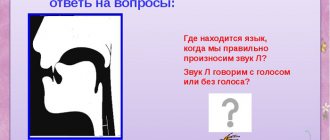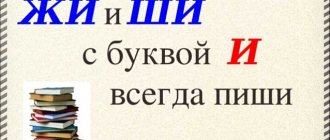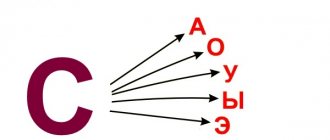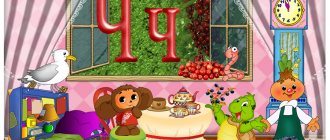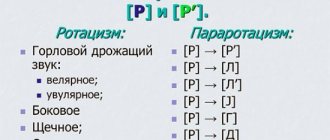Distinguishing the pronunciation of sounds in the absence of sound replacement
- First practice pronouncing that defective sound that the child used to have. You pronounce the words the way the child pronounced them before (that is, pronouncing the sound incorrectly), then correctly (sometimes vice versa). The child “guesses” when you pronounced the word correctly.
- The child must first pronounce words correctly, then the same way he pronounced them before (sometimes vice versa). You "guess" when he said it correctly and when he didn't. From time to time you will “make mistakes” (confuse correctly and incorrectly pronounced words), and the child must detect and correct these mistakes of yours.
- You pronounce the word the way the child used to pronounce it. He must “correct” your pronunciation - pronounce the word correctly.
- You pronounce a word correctly, and the child must repeat it after you the way he pronounced it before (defectively), and then “correct” his pronunciation.
- The child must first pronounce the word correctly, then the way he pronounced it before (defectively), then again correctly.
Distinguishing the pronunciation of sounds when replacing sounds
The work of distinguishing sounds will be described using the example of the sounds [s] and [w]. Expected situation: instead of the sound [w], the child pronounced the sound [s]. Pre-familiarize your child with the corresponding letters. Other symbols can be used: for example, the sound [s] (old pronunciation) may be indicated by a black circle, and the sound [w] (new pronunciation) may be indicated by a red circle.
Differentiation of sounds in an isolated position. When you show your child the letters [s] or [sh] (or symbols that replace them), he should pronounce the corresponding sounds.
Differentiation of sounds in syllables. You pronounce syllables very slowly, among which there are syllables with the sounds [s] and [sh], [ra], [shi], [lo], [su], [re], [sha], etc. Bogda child hears one of the differentiated sounds, he must show you a picture with the corresponding letter and name the sound that he heard.
Differentiation of sounds in words.
- You slowly pronounce words where the sounds [s] or [w] are at the beginning of the word (garden, son, fur coat, sleep, step, etc.), the child must name the sound with which the word begins. Make sure that you do not alternate words first with one sound, then with another, in this case the child will stop paying attention to the verbal material and will simply begin to raise his hand through the word.
- You pronounce simple words where the sounds [s] or [w] are in the middle of the word: porridge, braid, mustache, soul, ears, fox, etc. The task for the child is the same as in the previous case.
- You pronounce simple words where the sounds [s] and [w] are at the end of the word: forest, ladle, fox, mouse, shower, cape, etc. The task is the same as in previous cases. Be sure to ensure that among the words there are no words in which both differentiated sounds are simultaneously present.
- The child must come up with words that begin with the sound [s] or [sh].
- You name pairs of words that differ from each other in only one sound ([s] or [sh]), for example: bowl - bear, koska - cat, helmet - porridge, cape - mouse, etc. Having named a pair of such words ( for example, a braid is a cat), you ask the child questions, for example: “What can be braided on a girl’s head?”, “Who says meow?” The child must answer your question using the correct word.
- The child should repeat after you words that contain both differentiated sounds at once: highway, land, boxwood, pole, etc.
- The child should repeat after you words in which there are both differentiated sounds (as in the previous exercise) and words in which the same sound occurs twice (for example: kebab, nipple, checkers, etc.). In the latter case, the child often replaces the repeated sound with another (for example: shashlik - sashlyk or shashlik, soska - fry or shoska, etc.).
Differentiation of sounds in sentences. The child should repeat after you sentences in which differentiated sounds occur in large numbers, including in one word: Sasha is walking along the highway. The cat ate the mouse. Boxwood grows in the garden.
Differentiation of sounds from pictures
- The child must arrange the pictures whose names contain the sounds sounds [c] [w] into two piles: one with the sound [s], the other with the sound [w].
- The child must choose from a bunch of pictures those whose names contain the sound [s] (among the pictures there should also be pictures whose names contain the sound [w]). Then from the same pile you need to select those pictures whose names contain the sound [w].
Example words for differentiating sounds
Words for differentiating sounds [s - w]: Sasha, highway, land, drying, six, pole, wool, nimbleness, duchess, fascist, procession, knuckle, rustle, boxwood, weightlifter, wasteland, eared, chance, shepherdess, machinist, hornet, kebab, checker, cone, nipple, sausage, gopher, samsa, swineherd, space. Words for differentiating sounds [z - zh]: rod, lighter, yellowness, life, clamp, ignition, iron, healing, makeup artist, zhizha, ground beetle, excitement, splinter, gap, sweetheart, arrogant, zrazy. Words for differentiating sounds [ts - s]: tank, citrus, kingdom, stairs, desert, hotel, station, specialist, sun, village, abscess, oyster, process, male, tsatsa, tsetse fly, concept, Cicero, queen, stanzas , Stae, pacifier, iconostasis. Words for differentiating sounds [l - r]: roll, eagles, throat, lorgnette, Lara, overlock, Karl, Clara, drill, caravel, coral, den, marmalade, carnival, Frol, flora, formula, casket, charlatan, corporal, emergency, rapier, spring, castling, Aurora, resort, bell, balalaika, scrap metal, puzzle. Words for differentiating sounds [l - i]: husky, bark, apple, Yalta, balalaika, pancakes, blanket, spinning top, Christmas tree, slide, puff pastry, Dalai Lama, Jamaica, egg, bell, puzzle. Words for differentiating sounds [l' - i]: ruler, watering can, spruce, lily, beehive, glue, train, alley, manger, sculptor, Julia, hookah, Leah, skiff, lithium, alliance, flute, rut, Jamaica, egg , Lilya, Lala. Words for differentiating sounds [p - i]: paradise, swarm, Paradise, brightness, fair, yoke, region, edge, cut, troika, Ermak, moira, saury, yurt, fireworks, Beirut. Words for differentiating sounds [p' - th]: prairie, reika, Korean, Yuri, Guria, aria, Maria, boyar, mayor's office, Austria, fury, remake, Friedrich, refrain, referent, scrape, secretary, crossroads. Words for differentiating sounds [р' - l']: solarium, malaria, cavalryman, April, cleric, coppice, pilgrim, grill, charm, lyrics, prel, tide, healer, binding, quail. Words for differentiating sounds [t' - h]: teacher, bird, flow, seal, mosque, buckshot, first aid kit, reading, quarter, chick, respect, shadow, aunt, bowstring, black grouse, dot, scarecrow, why, drawing, tap dance .
Types of tasks
Differentiation of sounds in sentences and texts is the most productive stage from the point of view of developing program material. The following tasks are offered as training exercises:
- compare the paronymous words presented in the subject pictures by meaning and sound ( Mashka - mask ), pronounce them, make sentences according to a given scheme;
- make sentences based on the pictures, pronounce them, conduct oral and graphic analysis, write them down in a notebook, underline the letters being studied;
- insert the missing letters s or w into sentences similar to this one: “ Ko...ka...pit, and we...ku sees” ;
- perform an oral selective dictation (the speech therapist dictates sentences, the student listens, pronounces, identifies words with differentiated sounds and determines the place of sounds in a word);
- conduct an oral graphic analysis of the sentences proposed by the speech therapist and write them down in a notebook;
- perform a graphic dictation (the speech therapist dictates sentences, students identify words with the sound being studied, pronounce them and write them with the corresponding letter). Thus, the dictated sentence “ Pine trees are covered with fluffy caps.” in the recording they look like this: shs shss ;
- compose a story based on a plot picture, using words with differentiated sounds;
- listen to the story, make an outline of the text, retell it;
- select words with differentiable sounds from the text and write them down graphically. Then, using the diagram, answer the questions: how many syllables are there in a word? Which syllable has the differentiated sound? How many sounds are there in a syllable? etc.;
- read the text, inserting the missing letters s, sh : “ Shur...at...early li...tya. Pasta...ok pot...il k...ter”;
- read the text, restoring the letter s or w , and after parsing the sentence, write it down;
- fill in the missing words in the text containing the sounds s and sh ; guess the riddle, write down its text graphically under dictation; listen to the text. When reading independently again, restore the missing consonants s, w : a) orally (restore the corresponding letter), b) in writing (enter the letters): “ Enter the forest... and stroke the trees with your palm, as if ... patting old friends on the ... pinay ."
Rules for differentiating sounds
- If the child did not have a replacement of sounds (for example, he pronounced the sound [w] as an unclear hissing sound or the sound [r] - with one beat), it is very advisable to distinguish his old pronunciation from the new one. This will allow the child to quickly “get rid of” the previous defective pronunciation.
- If the child did not pronounce any sounds (missed them in speech), the need to differentiate these sounds disappears by itself (there is nothing to differentiate).
- If a child replaced a sound with some other sound (for example, [w] was pronounced as [s], or [r] as [l]), these sounds must be differentiated in order to prevent the child from developing reading and writing disorders.
- You can begin to differentiate sounds after the child freely pronounces them in syllables following you by imitation.
Differentiation of isolated sounds
(conducted as part of the lesson)
When differentiating isolated sounds, they rely on speech-motor, speech-auditory and visual analyzers.
For this stage of work, the teacher selects pictures-symbols for differentiated sounds. When practicing these sounds in previous groups, children were already taught to correlate sounds with a certain picture-symbol, and the developed stereotype must be used. The goal of the work is to teach how to distinguish sounds by comparing them according to their main qualitative characteristics - acoustic and articulatory.
The teacher slowly names the sounds, and the children show the corresponding pictures-symbols. This is how the ability to perceive their different sounds by ear is developed. Then symbol pictures are shown, and the children pronounce the corresponding sounds. The teacher asks what the lips and tongue do when pronouncing this or that sound. This is how the ability to determine the difference in the position of the main organs of the articulatory apparatus is developed when pronouncing differentiated sounds. The teacher, together with the children, sums up: what is the difference between differentiated sounds when they are perceived by ear and when pronounced.
Differentiation of sounds in words
(conducted as part of a lesson, in some cases, as a whole lesson)
The purpose of this stage of work is to teach children to isolate differentiated sounds from a word and not mix them up. When conducting an entire lesson, several types of work are used, which require the preparation of a large amount of verbal and visual material.
The teacher teaches to distinguish words that differ from each other by one of the differentiated sounds (paronyms). Using their example, he shows children that when one sound is replaced, the meaning of a word changes. The child explains the meaning of each word and indicates which word contains which sound. For example, the words teddy bear and bowl are suggested. The child says that the bear lives in the forest, and they eat from a bowl. In the word teddy bear there is a sound sh, in the word bowl there is a sound s. The teacher may ask: “What needs to be done to turn the word bear into the word bowl?” (“We must pronounce s instead of w”).
The teacher selects, according to the number of children, pictures (objects, toys), the names of which contain one of the differentiated sounds, and distributes them. Each child shows his picture, names it, highlighting the differentiated sound, and places it in an envelope attached to the board under the corresponding picture-symbol.
Children are offered words (names of toys, objects, pictures) that contain both differentiated sounds, for example: highway, drying, sun, etc. Children must correctly name pictures and toys without mixing up the sounds.
If differentiation of sounds in words is organized as part of a lesson, then one of the three listed types of work is used. At the same time, other types of work are carried out as part of the lesson in the future.
Differentiation of sounds in phrasal speech
(conducted as a whole lesson)
The teacher uses nursery rhymes, poems, tongue twisters, and stories rich in differentiated sounds in class. Children can come up with sentences themselves: based on a picture that shows an action with an object; using subject pictures familiar from previous classes; with the given word. The teacher gives instructions to come up with a sentence so that it contains as many words as possible with differentiated sounds, for example lyre (A policeman regulates traffic. A boat floats on a fast river. Fishermen have caught a lot of fish. The piano keys are white and black. Fish swim in an aquarium) , s and w (Sasha has a piece of glass on her palm. Sasha was walking along the highway. The shepherd is playing the pipe. Bumblebees are sleeping on the daisies, the baby frogs have gone to bed. Bucket sun, look out the window!), etc.
In this type of work, program material for speech development (correctly selected stories, songs, nursery rhymes, poems, pictures for composing stories, etc.) can be used.
Questions and tasks
What are the stages of work on sound formation and the requirements for their implementation?
Describe the stage of familiarization of children with the organs of the articulatory apparatus.
Describe the stage of clarifying the movements of the organs of the articulatory apparatus.
Tell us about the features of working with children at the stage of evoking sound by imitation.
Indicate what the teacher needs to take into account when selecting didactic material for classes at the stage of developing clear pronunciation of sounds in words.
What should a teacher pay attention to first of all in the process of teaching children the correct pronunciation of sounds in phrasal speech?
Describe the main stages of work on differentiating sounds.
Planning work to develop correct pronunciation
The main form of work with children on the formation of correct pronunciation is classes: frontal, subgroups and individual. (When getting acquainted with the practical material of this manual, presented in the form of stages of work, one should not forget that each stage is carried out either as a whole lesson on the sound culture of speech, or as part of any lesson on speech development, etc.).
Frontal work is carried out regularly with the entire group according to annual planning (see Table 4). When planning it, we proceed from the time allocated by the program for classes in the native language. Classes entirely devoted to the education of the sound culture of speech are held in the middle and senior groups approximately once a month, and more often in the younger groups. In addition, individual exercises in all groups, including the preparatory group, are included in other classes (at least once a week). For example, 5-7 minutes can be devoted to developing the sound culture of speech in classes such as memorizing poems, telling stories from a toy, or a picture.
Certain types of work on cultivating the pronunciation aspect of speech (development of auditory attention, speech breathing, tempo, rhythm of speech) can also be included in musical classes.
Thus, work on pronunciation education is carried out once a month as an independent (whole) lesson on the sound culture of speech and once a week as part of a lesson (on the native language, music, etc.). These classes are carefully prepared by the teacher. Carrying out frontal work, the teacher can see how each child assimilates the program material and the difficulties that arise in individual children. This gives the teacher the opportunity to outline a plan for future activities, think through what to do next with the child, what and how to work with him in subsequent stages.
Work in subgroups is carried out with those children who have not mastered the program material of the frontal lesson. It is organized 2-3 times a week in the morning (before breakfast) or in the evening (after a nap and before going home). The composition of the subgroup (no more than 4-6 children) changes, since during frontal work difficulties may arise in different children. For some, preparatory exercises for the correct pronunciation of a sound are difficult, for others - clarifying an isolated sound or pronouncing it in words. Those children who were absent from the front lesson are also included in these subgroups. Working with subgroups, the teacher eliminates the difference in children’s skills and abilities, and children, in turn, have the opportunity to master subsequent program material in front-line classes.
Individual work on the formation of sound pronunciation skills is carried out at a time convenient for the teacher with children who have not mastered the sound pronunciation material provided for the entire group. Classes in subgroups are also not sufficient for them.
Work with children should be carried out according to an individual plan drawn up by the teacher together with a speech therapist. Parents should take an active part in it, performing certain tasks with the child at home, suggested by the teacher and speech therapist. If necessary, children who later entered kindergarten or missed a lot due to illness are involved in individual lessons. With such children, they individually practice the material covered with the whole group. Children with whom individual lessons are conducted are not exempt from participation in general frontal work on sound pronunciation.
Questions
What are the features of organizing frontal classes?
How to organize work with subgroups of children?
How is individual work carried out?
Approximate work plan for the year
Table 4
Let's together teach children to speak clearly and correctly, easily and beautifully!
Contained in sections:
- Letters. Getting to know letters and sounds 2687
- Speech therapy classes 9320
- Literacy training. Sounds, letters, syllables 8907
Includes sections:
- Differentiation, automation of sounds. Didactic games 377
- Sounds [L] - [R]. Differentiation of sounds 157
- Sounds [L], [L']. Automation, sound differentiation 698
- Sounds [S] - [Sh]. Differentiation of sounds 438
By groups:
- Senior group
- Preparatory group
- Middle group
Showing publications 1-10 of 3991. All sections | Sound differentiation and automation
New
Photo
The best
Summary of a speech therapy lesson with children 6–7 years old on the topic “Sea inhabitants. Automation of sound [P]" Synopsis of a speech therapy lesson on sound pronunciation . Topic: “Sea inhabitants”
.
Goal: Automation of sound [P] . Objectives: 1. Educational: - clarify children’s ideas about the sound [P] .
- enrichment of children's vocabulary. 2. Correctional and developmental: - clarify ideas about... Game techniques for automating sounds MBDOU "Kindergarten No. 182" g.o. Samara Game techniques for automating sounds Educator : Mikheeva Lyudmila Viktorovna 2021 "Game techniques for automating sounds "
The child’s speech develops gradually. In preschool age, much attention is paid to the formation of correct...
A collection of didactic games for differentiating mixed sounds in preschool children
MUNICIPAL STATE PRESCHOOL EDUCATIONAL INSTITUTION KINDERGARTEN No. 381
COLLECTION OF DIDACTIC GAMES
TO DIFFERENTIATE MIXED SOUNDS
IN PRESCHOOL CHILDREN
WITH SPEECH DISORDERS
Compiled by – teacher-speech therapist Leonova Natalya Grigorievna
Speech therapy work on the formation of auditory differentiation of specific pairs of mixed sounds includes two stages (R.I. Lalaeva): the first is a preliminary stage of work on each of the mixed sounds; the second is the stage of auditory and pronunciation differentiation of mixed sounds.
At the first stage, the pronunciation and auditory image of each of the mixed sounds is sequentially refined. The work is carried out according to the following plan.
• Clarification of sound articulation based on visual, auditory, tactile perception, and kinesthetic sensations.
• Isolation of sound against the background of a syllable.
• Formation of the ability to determine the presence of sound in a word.
• Isolating a word with a given sound from a sentence.
At the second stage, a comparison of specific mixed sounds is carried out in pronunciation and auditory terms. Differentiation of sounds is carried out in the same sequence as at stage I. However, the main goal of stage II is to distinguish sounds, so speech material includes words with mixed sounds.
Working with preschool children, I was faced with the fact that the period of automation and differentiation of assigned sounds is quite long and requires a variety of tasks and play exercises.
Thinking about how to make individual and subgroup lessons on developing correct sound pronunciation more interesting, educational and educational for children, I began to look for games in specialized literature, the Internet and invent games myself. I systematized all the collected material into stages of work.
The goal of all the games in this collection is to reinforce the correct pronunciation of sounds in words and differentiate mixed sounds in words (stage II of speech therapy work). In all games, speech material can be used for any oppositional sounds: [S-Sh], [S-Z], [S-C], [Z-Zh], [Sh-Zh], [Ch-Shch], [R -L]. Most games are effectively played electronically using Smart Notebook or Microsoft Office PowerPoint.
OUTDOOR GAMES
"Show with your hand"
Material: subject pictures, words with differentiated sounds.
Progress of the game: the speech therapist pronounces the words, the children show the signal with a hand movement. For example, [Ш] - hand movement - “crawling already”, [F] - finger movements imitating how beetles move their legs.
"Ringing and buzzing"
Material: words, object pictures for differentiable sounds.
Progress of the game: the driver is selected and leaves the room. The remaining children each come up with one word or choose a picture whose name contains the sound [Z] or [Z]. The driver, having returned, approaches each child, and he says a word to him. If the driver hears the sound [Z] in a word, then he says “Rings,” if [F], then he says: “Buzzes.”
“We ran away and gathered”
Material: symbols of mixed sounds, located in different parts of the room, object pictures of differentiated sounds.
Progress of the game: the speech therapist names words with differentiated sounds (or shows the corresponding subject pictures). Children run to the sound symbol contained in the word (the name of the picture).
WALKING GAMES
“Who will pack their things faster?”
Material: large card with 2 suitcases in the middle. Pieces of clothing are drawn in a circle, the names of which contain the sound [S] or [SH]. Between the objects there are circles from one to five, chips, a cube.
Progress of the game: two children play. One child must pack things in a suitcase whose names contain the sound [S], the other - [SH]. Children take turns throwing the dice and moving their chip by as many circles as they appear. If the chip lands on an object that has the sound the child needs in its name, he places a cardboard square on his suitcase. The one who packs the most things into his suitcase wins.
"Soundtrack"
Material: a large card with a chain of subject pictures drawn on it for differentiable sounds.
Progress of the game: participants place chips at the start. Players take turns throwing the dice and moving the chips around the playing field, naming the drawn pictures and determining what sound is in the word and covering the picture with the desired card. For example, with the sound [Zh] - beetle, with the sound [Ш] - snake (it is possible to use letter-symbols of sounds). The game ends when all the pictures are covered. Game option. You can only walk along a path with object pictures for a specific sound.
GAMES WITH PICTURE DISTRIBUTION
"Fisherman"
Materials: a fishing rod with a magnet, object pictures whose names contain differentiated sounds, two buckets with pockets for symbols of sounds.
Progress of the game: children take turns catching pictures with a fishing rod. They determine the presence of a particular sound and put the picture in the appropriate bucket.
"Train"
Material: two paper train cars with pockets for symbols of sounds, object pictures, the names of which contain differentiable sounds.
Game progress: place passengers in carriages.
"Shop"
Material: large card divided into 3 strips (store shelves). The stripes are drawn into squares, in which items of clothing, dishes, money are drawn - symbols of sounds.
Progress of the game: each child is given 6 squares with any one letter. With your own money you can buy those items whose names contain this sound. The one who spends his money faster wins.
Second option. Letter money lies on the table with the images down, each player takes one for himself and buys the corresponding product.
"Build a house"
Material: subject pictures on rectangles (bricks) - for differentiated sounds, on a large triangle (roof) - a pocket for letters (symbols of sounds).
Progress of the game: build a house for the heroes, for example, for the Larisa doll, choosing only bricks whose pictures have the sound [L] in their names, and for the robot Roma - with the sound [R].
"Collect a flower"
Material: subject pictures on colored petals and letters (symbols of sounds) on the round core of the flower.
Progress of the game: collect flowers by choosing petals with pictures of the given sounds.
"Let's decorate the room with flags"
Material: two stretched ropes, object pictures (with differentiated sounds), pasted onto multi-colored flags.
Progress of the game: the teacher informs the child that a holiday is coming. In honor of the holiday, the speech therapist suggests decorating the office with flags with pictures, choosing only flags with pictures for the given sounds - one string with the sound [S], the other with the sound [Z].
"Let's decorate the Christmas tree"
Material: silhouettes of two Christmas trees (with pockets for symbols of sounds), on which small buttons are attached using wire, small circles with a loop of braid - “Christmas tree balls”, on which object pictures are glued.
Progress of the game: the teacher invites the child to decorate the Christmas tree with balls on which pictures with differentiated sounds are drawn, attaching the balls with a loop to the Christmas tree.
"Sun"
Material: subject pictures on yellow rectangles (rays) and symbols of differentiated sounds on yellow circles (2 suns).
Progress of the game: the teacher invites the child to collect rays for the sun, choosing only those whose names contain a given sound.
"Collect apples"
Material: subject pictures on apples made of green cardboard, 2 baskets with slots for symbols of sounds.
Progress of the game: the teacher says that the wind shook the apple tree and apples fell from it. It is necessary to collect apples in baskets. For example, in the hare’s basket you need to collect apples with pictures with the sound [Z], and in the dog’s basket you need to collect apples with pictures with the sound [S]. Similar games are played: “Collect carrots”, “Collect pears”, etc.
"Make a pyramid"
Material: subject pictures pasted onto multi-colored rings of different sizes.
Progress of the game: the teacher invites the child to put together two pyramids of figures, choosing only those figures on which a picture with a given sound is pasted, for example, one pyramid with the sound [Ts], the other - [H]. The child must fold the pyramid according to all the rules, selecting rings in decreasing order. The shapes for the pyramid can be of a wide variety of shapes: ovals, rectangles, squares, trapezoids, etc.
"Give the doll some tea"
Material: subject pictures pasted onto colored cardboard cups, doll.
Progress of the game: the teacher introduces the child to the dolls Zhenya and Zina, telling them that they are very capricious - they like to drink tea only from cups on which pictures are drawn with their favorite sounds [F] and [Z]. Among the many cups, the speech therapist teacher asks you to find those with such pictures.
"Aquarium"
Material: two drawn aquariums with pockets (for symbols of sounds), multi-colored aquarium fish made of paper with object pictures of differentiated sounds pasted on the reverse side.
Progress of the game: you need to place the fish in the aquariums.
"Refuel the car"
Material: two painted gas pumps with pockets for symbols of sounds, cars with object pictures of differentiated sounds pasted on the back side.
Progress of the game: cars “carry” pictures with different sounds; you can refuel the car only at a certain gas station - with the sound that is in the name of the picture on the typewriter.
"Washing machine"
Material: two washing machines with pockets for symbols of sounds, object pictures depicting clothes for differentiated sounds.
Progress of the game: you need to wash things by putting them in a certain washing machine. If the typewriter has a sound symbol [Ш], then the name of the clothing should also have this sound.
"Postman"
Material: two mailboxes with sound symbols attached to them, letters with subject pictures for differentiated sounds.
Progress of the game: the child selects a “letter” and puts it in the desired mailbox.
"Balloons"
Material : images of two girls, balloons with object pictures glued on the back side for differentiable sounds.
Progress of the game: Lena and Raya were given balloons. On Lena's balloons there are pictures with the sound [L]. On the balloons of Paradise there are pictures with sound [P]. Find out where whose balls are. The child names the picture, identifies the sound in the name of the object and lays out the pictures for the girls.
"Fold the flower"
Material: flower petals, 6 pieces of different colors, on the back side there are object pictures glued to differentiable sounds, yellow “centers” of flowers with letters (symbols of sounds) written on them.
Progress of the game: the child arranges flower petals around the “centers”, choosing pictures with the desired sound.
"Doctor Sounds"
Material: figure of Doctor Zvukov, cardboard bottles with subject pictures pasted on them, the names of which contain differentiated sounds, figures of “sick” animals.
Progress of the game: the animals are sick, Doctor Zvukov prescribes medicine for them. For a snake - with the sound [Z], for a beetle - with the sound [Zh], etc.
"Kick the ball into the goal"
Material: a football field with two painted goals (there are pockets on them for differentiated sounds), cut out soccer balls with object pictures of differentiated sounds pasted on the back side.
Progress of the game: two children play. They are asked to “score goals” - place the ball in the right goal: one child needs to choose pictures with the sound [P], the other - with the sound [L]. For each correctly placed ball, one point is awarded. The one who scores the most goals wins.
GAMES WITH SELECTION OF A PICTURE WITH THE NECESSARY SOUND
"Fix the alarm clock"
Material: watch dial with object pictures drawn along the edge in pairs for mixing sounds (helmet and kashka, fur coat and cheese, pants and glass, etc.), blue figures attached with buttons along the edge of the circle so that they cover half the circle , i.e. one picture (helmet, cheese, glass, etc.).
Progress of the game: the alarm clock is broken. To repair it, you need to hide the pictures with sound [C]. In this case, pictures with the sound [Ш] will remain. When the child does everything correctly, the speech therapist rings a bell (or gives another sound signal).
Second option. The teacher closes the pictures himself, making a mistake. The child’s task is to find the mistake, i.e. fix the alarm clock.
"Collect the beads"
Material: long cord, object pictures (with oppositional sounds), pasted onto small multi-colored circles, along the edges of which two holes were made using a hole punch.
Progress of the game: children take turns collecting beads, one chooses pictures with the sound [Ш], the other - with the sound [Zh].
GAMES USING SOUND SYMBOLS
"Colorful clothespins"
Material: a circle cut out of cardboard, along the edge of which pictures with differentiated sounds are placed, colored clothespins.
Progress of the game: you need to “decorate” the circle, attach a clothespin of a certain color to the picture. For example, a green clothespin is attached to a picture with the sound [З], a blue one with the sound [С], etc.
"Magic Carousel"
Material: two circles cut out of cardboard are attached side by side to the base so that they can rotate. Pictures with differentiated sounds are placed along the edge of one circle, and symbols of these sounds are placed on the other.
Progress of the game: the child rotates the circles in such a way as to make pairs - a picture and a sound symbol, which is in the name of this picture.
Second option. On both circles there are object pictures with differentiated sounds. One of the children rotates the first circle, the other rotates the second circle so that opposite the picture from the first circle is a picture with the same sound.
"Sound Clock"
Material: a cardboard circle is divided into two halves, object pictures with differentiable sounds [С, З, Ц, Ш, Ж] are pasted on one edge, and symbols of these sounds (letters or pictures: [С] – teapot with steam, [Z] – mosquito, [C] – squirrel, [W] – snake, [F] – beetle). In the middle of the circle are two rotating arrows.
Game progress: the child rotates the arrow. If it stops in front of the sound symbol, the child connects it with a picture whose name contains this sound. If the arrow stops opposite the picture, the child connects it with the corresponding symbol.
"Cube"
Material: a cube with an image of a sound symbol or a letter attached to each side, object pictures with differentiated sounds.
How to play: Children take turns throwing the dice. The child throwing the dice must find the sound whose symbol is on top in the names of the displayed pictures. If the child completes the task correctly, he takes the picture for himself. The one with the most pictures wins.
"Sound House"
Material: houses drawn on cardboard with pockets-windows for a sound symbol (on the roof) and for object pictures (on the wall), object pictures of “guests” with differentiated sounds.
Progress of the game: the house invites guests. It is necessary to place pictures in pockets depending on the sound that is in the name of the “guest”.
"Sound Lotto"
Material: large cards with object pictures drawn on them for oppositional sounds (4 pictures each with the sounds [S], [Z], [W], [F]), chips, symbols of these sounds, a magic bag.
Progress of the game: children are given cards, the speech therapist (leader) takes out a sound symbol from a magic bag, children close the picture on their card, the name of which contains this sound.
COLORING GAMES
"Editor"
Materials: sheets with drawn subject pictures of oppositional sounds, colored pencils.
Progress of the game: the child is asked to cross out pictures with one sound, and circle pictures with another.
"Artist"
Materials: sheets with drawn subject pictures of oppositional sounds, colored pencils.
Progress of the game: you need to color the pictures with a certain color. For example, with the sound [S] - blue, [Z] - green, [Zh] - yellow, etc.
All these games will help your child make the long stage of automation and differentiation of sounds interesting and exciting. The child will be happy to attend individual lessons with a speech therapist teacher, and, consequently, work efficiency will increase.
Information sources:
- Ermolaeva N.K. Teaching reading in the pre-letter period // Speech therapist, 2004, No. 3. – P.69 – 84.
- Games for automation and differentiation of sounds in preschool children / L. N. Shinkareva. — 2nd ed. — Mozyr: LLC Publishing House “Bely Veter”, 2008.
- Kovshikov V.A. Correction of sound discrimination disorders. Methods and didactic materials / V.A. Kovshikov. – M.: St. Petersburg, 1995.
- Lalaeva R.I. Reading disorders and ways of their correction in primary schoolchildren: Textbook. – St. Petersburg: SOYUZ, 1998.
- Reading and writing according to the D.B. system Elkonina: A book for teachers. - M.: Education, 1993.
- Shvaiko G.S. 'Games and play exercises for speech development.
- https://festival.1september.ru Sergeeva O. A. We play with children - we develop speech
- https://www.liveinternet.ru Games with clothespins.
- https://logorina.ru Phonemic hearing.
14
